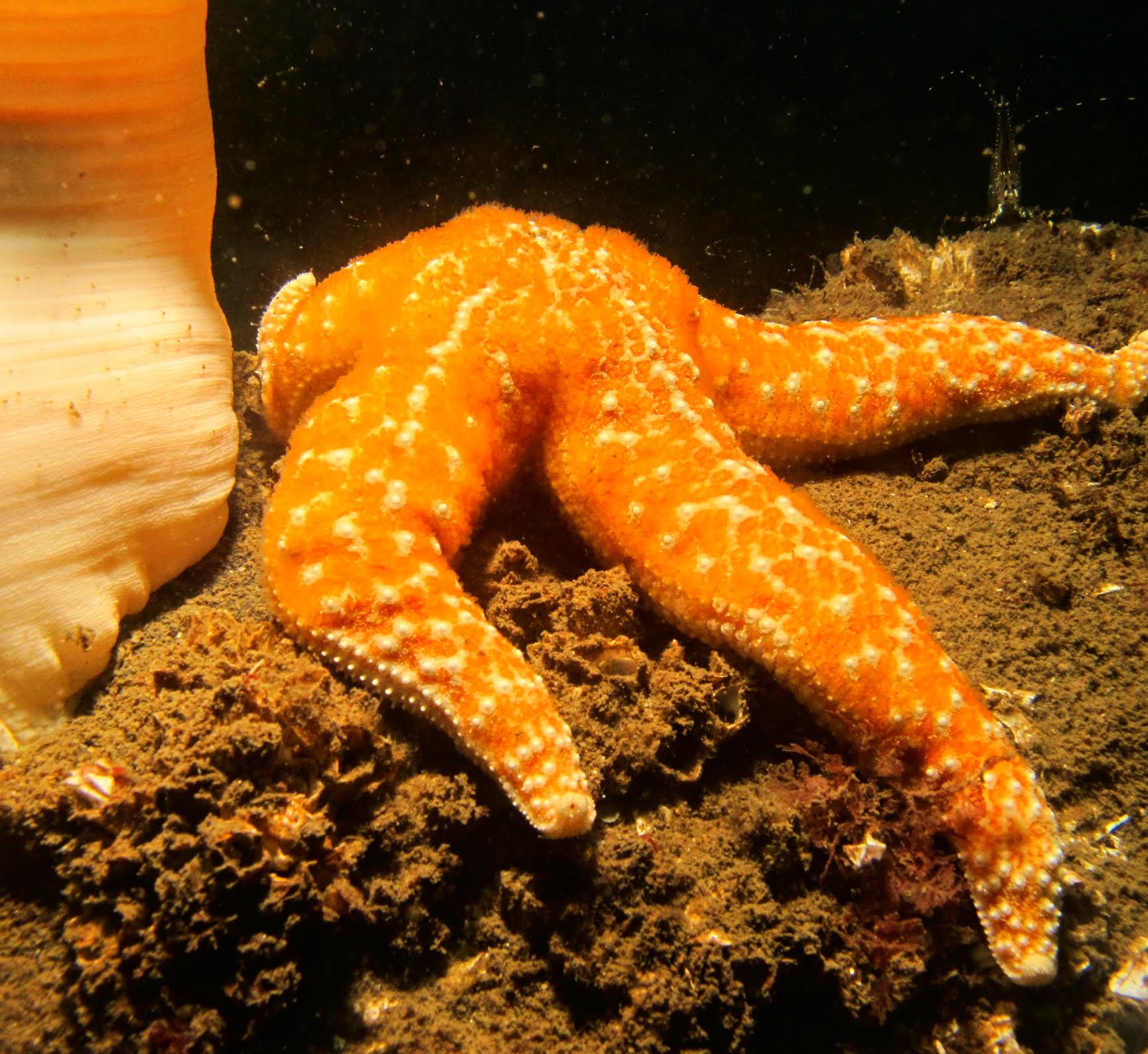Update January 21, 2016
Scientists from all over the US and Canada who are studying this disease came to share their research and learn from each other.
We still have a lot to learn about this disease, but data presented support: (1) this is an unsual mortality event, (2) the disease hits a wide range of sea star species, and (3) it affects different species of sea stars differently. Species that seem have been hit hard both in the wild and in captivity include the mottled star (Evasterias troschelii; pictured here), sunflower star (Pycnopodia heliantoides), spiny pink star (Pisaster brevispinus) and the ochre sea star (Pisaster ochraceus).
Joe Gaydos notes, "I'm impressed with and inspired by all of the great scientific minds working to unravel this mystery!"

Update November 17 2014
Work is continuing to better understand the other factors involved in this outbreak and how this massive loss of predators will reshape the marine ecosystem.
Understanding emerging threats to the health of our oceans is a key part of SeaDoc's work, and donations to SeaDoc make it possible.
Read the paper by Ian Hewson, et al.: http://www.seadocsociety.org/?p=2949
Earthfix covered the study, noting that this virus is different from all known viruses infecting marine organisms. (Another little-known fact: a drop of seawater contains about 10 million viruses.)
Read it: Scientists find out what's killing west coast starfish
Smithsonian Magazine also has a good article about the study and what it means.
Update October 2014
The article is well-worth a read, and here's a video from it:
Update June 2014
Scientists are closer to having an answer to what's causing the mortality outbreak in sea stars. Drew Harvell of Cornell University and Friday Harbor Labs is working with a team that has traced the cause.
Read the latest article from KUOW's EarthFix team about the current status of the outbreak. There's also a terrific video on that page featuring Drew Harvell.
Sea stars in various parts of the Salish Sea are experiencing a mass-mortality event. We're not sure of the cause, but we're working on it. (So are many other groups in the area.)
In October we looked for healthy and diseased sea stars during our dives for our new subtidal survey project. (See what else we found on those dives here.) During early November, we returned to two of the REEF monitoring sites from October where we saw the highest density of sea stars to see if sea star wasting disease has shown up since were were there last month. Fortunately we saw numerous sea stars and numerous species of sea stars and they all looked healthy. We will continue dives this weekend to look for more signs of disease.
Photos of diseased sea stars
Seastar expert Neil McDaniel, (www.seastarsofthepacificnorthwest.info) has graciously shared his photos showing the progression of the disease over a short period of a few weeks. This can give you an idea of what you're looking for. The before-and-after photos are pretty shocking. View the photos at Janna Nichols' SCUBA photo page.
Report sick and healthy sea stars
If you're a diver or a beach-walker and you see sea stars (healthy or diseased), report them at the Vancouver Aquarium's Sea Star Wasting Syndrome web page.
That page at the Vancouver Aquarium's website also has an overview of the outbreak.
Also see these media articles:
http://kuow.org/post/mass-starfish-die-may-be-headed-washington
http://www.king5.com/news/environment/Biologists-search-for-cause-of-sea-star-deaths-229408861.html
Vancouver Sun: scientists narrow in on the wasting disease (May 2014)
Video:
The Vancouver Aquarium made a time-lapse video of a sea star disintegrating. Watch it here: http://youtu.be/mjrp3Eckr-E
Audio:
Seattle Aquarium veterinarian Lesanna Lahner was interviewed on Science Friday on NPR on December 5, 2014.
Other items:
The Northwest Indian Fisheries Commission posted a blog entry about how the Puyallup Tribe is tracking sea star wastage in the South Sound.
Scientist Drew Harvell and diver Laura James wrote a blog post for the Nature Conservancy about the outbreak. In it, Harvell, who is one of the scientists doing genetic research on possible disease vectors, makes the case for better funding of scientific investigations of disease in the ocean.
Page updated on December 10, 2014



